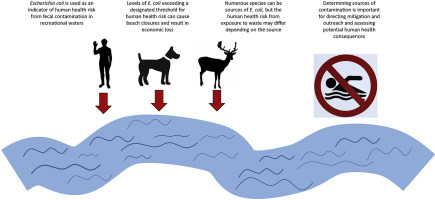当前位置:
X-MOL 学术
›
Water Res.
›
论文详情
Our official English website, www.x-mol.net, welcomes your
feedback! (Note: you will need to create a separate account there.)
Microbial source tracking (MST) in Chattahoochee River National Recreation Area: Seasonal and precipitation trends in MST marker concentrations, and associations with E. coli levels, pathogenic marker presence, and land use.
Water Research ( IF 11.4 ) Pub Date : 2019-12-26 , DOI: 10.1016/j.watres.2019.115435 By Anna McKee 1 , Marirosa Molina 2 , Mike Cyterski 2 , Ann Couch 3
Water Research ( IF 11.4 ) Pub Date : 2019-12-26 , DOI: 10.1016/j.watres.2019.115435 By Anna McKee 1 , Marirosa Molina 2 , Mike Cyterski 2 , Ann Couch 3
Affiliation

|
Escherichia coli levels in recreational waters are often used to predict when fecal-associated pathogen levels are a human health risk. The reach of the Chattahoochee River that flows through the Chattahoochee River National Recreation Area (CRNRA), located in the Atlanta-metropolitan area, is a popular recreation area that frequently exceeds the U.S. Environmental Protection Agency beach action value (BAV) for E. coli. A BacteriALERT program has been implemented to provide real-time E. coli estimates in the reach and notify the public of potentially harmful levels of fecal-associated pathogens as indicated by surrogate models based on real-time turbidity measurements from continuous water quality monitoring stations. However, E. coli does not provide information about the sources of fecal contamination and its accuracy as a human health indicator is questionable when sources of contamination are non-human. The objectives of our study were to investigate, within the Park and surrounding watersheds, seasonal and precipitation-related patterns in microbial source tracking marker concentrations of possible sources (human, dog, and ruminant), assess correlations between source contamination levels and culturable E. coli levels, determine which sources best explained model-based E. coli estimates above the BAV and detection of esp2 (a marker for the esp gene associated with pathogenic strains of Enterococcus faecium and Enterococcus faecalis), and investigate associations between source contamination levels and land use features. Three BacteriALERT sites on the Chattahoochee River were sampled six times per season in the winter and summer from December 2015 through September 2017, and 11 additional stream sites (synoptic sites) from the CRNRA watershed were sampled once per season. Samples were screened with microbial source tracking (MST) quantitative PCR (qPCR) markers for humans (HF183 Taqman), dogs (DogBact), and ruminants (Rum2Bac), the esp2 qPCR marker, and culturable E. coli. At the BacteriALERT sites, HF183 Taqman concentrations were higher under wet conditions DogBact concentrations were greater in the winter and under wet conditions, and Rum2Bac concentrations were comparatively low throughout the study with no difference across seasons or precipitation conditions. Concentrations of HF183 Taqman, DogBact, and Rum2Bac were positively correlated with culturable E. coli concentrations; however, DogBact had the largest R2 value among the three markers, and the forward stepwise regression indicated it was the best predictor of culturable E. coli concentrations at the BacteriALERT sites. Recursive partitioning indicated that BAV exceedances of model-based E. coli estimates were best explained by DogBact concentrations ≥3 gene copies per mL (CN/mL). Detections of esp2 at BacteriALERT sites were best explained by DogBact concentrations ≥11 CN/mL, while detections of esp2 at synoptic sites were best explained by HF183 Taqman ≥29 CN/mL. At the synoptic sites, HF183 Taqman levels were associated with wastewater treatment plant density. However, this relationship was driven primarily by a single site, suggesting possible conveyance issues in that catchment. esp2 detections at synoptic sites were positively associated with development within a 2-km radius and negatively associated with development within the catchment, suggesting multiple sources of esp2 in the watershed. DogBact and Rum2Bac were not associated with the land use features included in our analyses. Implications for Park management include: 1) fecal contamination levels were highest during wet conditions and in the off season when fewer visitors are expected to be participating in water-based recreation, 2) dogs are likely contributors to fecal contamination in the CRNRA and may be sources of pathogenic bacteria indicating further investigation of the origins of this contamination may be warranted as would be research to understand the human health risks from exposure to dog fecal contamination, and 3) high levels of the human marker at one site in the CRNRA watershed suggests more extensive monitoring in that catchment may locate the origin of human fecal contamination detected during this study.
中文翻译:

查塔胡奇河国家游乐区的微生物源跟踪(MST):MST标记物浓度的季节性和降水趋势,以及与大肠杆菌水平,致病性标记物的存在和土地利用的关联。
休闲水域中的大肠杆菌水平通常用于预测粪便相关病原体水平何时会危害人类健康。流经位于亚特兰大都市区的查塔胡奇河国家游乐区(CRNRA)的查塔胡奇河的上游河段是一个受欢迎的娱乐区,经常超过美国环境保护署对大肠杆菌的海滩行动价值(BAV)。 。已实施BacteriALERT程序,以提供实时的大肠杆菌估计值,并通知公众粪便相关病原体的潜在有害水平,这是由基于连续水质监测站实时浊度测量值的替代模型所表明的。但是,E。大肠杆菌不提供有关粪便污染源的信息,当污染源为非人类时,大肠菌作为人类健康指标的准确性令人怀疑。我们研究的目的是在公园及周边流域内调查微生物源中与季节和降水有关的模式,以追踪可能的源(人,狗和反刍动物)的标记物浓度,评估源污染水平与可培养E之间的相关性。大肠埃希氏菌水平,确定哪些来源能最好地解释基于模型的大肠埃希菌估计值高于BAV并检测esp2(与粪肠球菌和粪肠球菌致病菌株相关的esp基因的标记),并调查来源污染水平与土地之间的关联使用功能。从2015年12月至2017年9月,在冬季和夏季,每个季节对查塔胡奇河上的三个BacteriALERT站点进行采样,每次采样六次,并且每个季节对CRNRA流域的另外11个河流站点(天气站点)进行采样。使用针对人类(HF183 Taqman),狗(DogBact)和反刍动物(Rum2Bac),esp2 qPCR标记和可培养大肠杆菌的微生物源跟踪(MST)定量PCR(qPCR)标记筛选样品。在BacteriALERT站点,在潮湿条件下,HF183 Taqman浓度较高,在冬季和潮湿条件下,DogBact浓度较高;在整个研究过程中,Rum2Bac浓度相对较低,在整个季节或降水条件下均无差异。HF183 Taqman,DogBact和Rum2Bac的浓度与可培养E呈正相关。大肠杆菌浓度;但是,DogBact在这三个标记中的R2值最大,并且逐步逐步回归表明它是BacteriALERT位点可培养大肠杆菌浓度的最佳预测指标。递归划分表明,DogBact浓度≥3个基因拷贝/ mL(CN / mL)可以最好地解释基于模型的大肠杆菌估计值超出BAV的情况。DogBact浓度≥11CN / mL可以最好地解释在BacteriALERT部位的esp2检测,HF123 Taqman≥29CN / mL可以最好地解释在天气部位的esp2检测。在天气站点,HF183 Taqman的水平与废水处理厂的密度有关。但是,这种关系主要是由一个站点驱动的,这表明该流域可能存在运输问题。天气区的esp2检测与2公里半径范围内的发育呈正相关,与集水区内的发育呈负相关,这表明流域内有esp2的多种来源。DogBact和Rum2Bac与我们分析中包含的土地利用功能无关。对公园管理的影响包括:1)在潮湿条件下和淡季,粪便污染水平最高,而预计淡季游客会参加水上娱乐活动; 2)狗可能是CRNRA中粪便污染的原因,并且可能是可能需要进一步调查这种污染源的病原细菌来源,以及为了了解暴露于狗粪污染而对人类健康构成威胁的研究,
更新日期:2019-12-27
中文翻译:

查塔胡奇河国家游乐区的微生物源跟踪(MST):MST标记物浓度的季节性和降水趋势,以及与大肠杆菌水平,致病性标记物的存在和土地利用的关联。
休闲水域中的大肠杆菌水平通常用于预测粪便相关病原体水平何时会危害人类健康。流经位于亚特兰大都市区的查塔胡奇河国家游乐区(CRNRA)的查塔胡奇河的上游河段是一个受欢迎的娱乐区,经常超过美国环境保护署对大肠杆菌的海滩行动价值(BAV)。 。已实施BacteriALERT程序,以提供实时的大肠杆菌估计值,并通知公众粪便相关病原体的潜在有害水平,这是由基于连续水质监测站实时浊度测量值的替代模型所表明的。但是,E。大肠杆菌不提供有关粪便污染源的信息,当污染源为非人类时,大肠菌作为人类健康指标的准确性令人怀疑。我们研究的目的是在公园及周边流域内调查微生物源中与季节和降水有关的模式,以追踪可能的源(人,狗和反刍动物)的标记物浓度,评估源污染水平与可培养E之间的相关性。大肠埃希氏菌水平,确定哪些来源能最好地解释基于模型的大肠埃希菌估计值高于BAV并检测esp2(与粪肠球菌和粪肠球菌致病菌株相关的esp基因的标记),并调查来源污染水平与土地之间的关联使用功能。从2015年12月至2017年9月,在冬季和夏季,每个季节对查塔胡奇河上的三个BacteriALERT站点进行采样,每次采样六次,并且每个季节对CRNRA流域的另外11个河流站点(天气站点)进行采样。使用针对人类(HF183 Taqman),狗(DogBact)和反刍动物(Rum2Bac),esp2 qPCR标记和可培养大肠杆菌的微生物源跟踪(MST)定量PCR(qPCR)标记筛选样品。在BacteriALERT站点,在潮湿条件下,HF183 Taqman浓度较高,在冬季和潮湿条件下,DogBact浓度较高;在整个研究过程中,Rum2Bac浓度相对较低,在整个季节或降水条件下均无差异。HF183 Taqman,DogBact和Rum2Bac的浓度与可培养E呈正相关。大肠杆菌浓度;但是,DogBact在这三个标记中的R2值最大,并且逐步逐步回归表明它是BacteriALERT位点可培养大肠杆菌浓度的最佳预测指标。递归划分表明,DogBact浓度≥3个基因拷贝/ mL(CN / mL)可以最好地解释基于模型的大肠杆菌估计值超出BAV的情况。DogBact浓度≥11CN / mL可以最好地解释在BacteriALERT部位的esp2检测,HF123 Taqman≥29CN / mL可以最好地解释在天气部位的esp2检测。在天气站点,HF183 Taqman的水平与废水处理厂的密度有关。但是,这种关系主要是由一个站点驱动的,这表明该流域可能存在运输问题。天气区的esp2检测与2公里半径范围内的发育呈正相关,与集水区内的发育呈负相关,这表明流域内有esp2的多种来源。DogBact和Rum2Bac与我们分析中包含的土地利用功能无关。对公园管理的影响包括:1)在潮湿条件下和淡季,粪便污染水平最高,而预计淡季游客会参加水上娱乐活动; 2)狗可能是CRNRA中粪便污染的原因,并且可能是可能需要进一步调查这种污染源的病原细菌来源,以及为了了解暴露于狗粪污染而对人类健康构成威胁的研究,











































 京公网安备 11010802027423号
京公网安备 11010802027423号